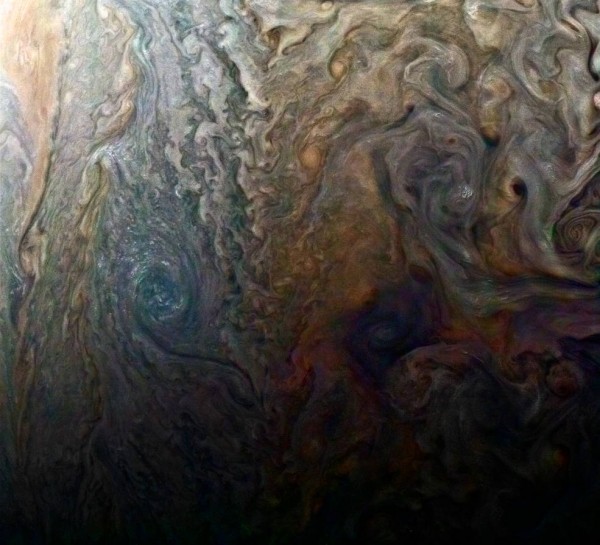By Ana Verayo, | March 28, 2017

This enhanced-color image of a mysterious dark spot on Jupiter seems to reveal a Jovian “galaxy” of swirling storms.
NASA's Jupiter spacecraft Juno zoomed in closer to the gas giant yesterday making this its fifth flyby. Juno completed its closest approach to Jupiter at 4:52 A.M. EDT while grazing the swirling cloudtops at speeds of 129,000 miles per hour.
NASA's Juno spacecraft has been preparing for this particular flyby as its scientific suite of instruments were all operational in order to collect new data. Juno will be collecting measurements and will be studying Jupiter's atmosphere, electromagnetic fields and gravitational forces. Its onboard camera JunoCam also captured never before seen color photos of this colossal, enigmatic world.
Like Us on Facebook
According to Juno mission's principal investigator, Scott Bolton from the Southwest Research Institute, this is the spacecraft's fourth science pass and its fifth close flyby of Jupiter during this mission. We are truly excited to see the new discoveries Juno will later on reveal. For every time that the probe approaches Jupiter's cloudtops, we collect valuable data and crucial new findings that shed more light in understanding the processes of this giant planet.
Juno arrived at Jupiter's orbit last July 2016 after travelling for almost five years across the solar system. After arriving, Juno has already presented a treasure trove of scientific discoveries about the gas giant's compositions and atmospheric structure and conditions. The spacecraft also revealed Jupiter's incredible auroras and dangerous magnetic fields.
Since the probe is currently at a highly elliptical orbit around Jupiter, this means that close approaches like this can only occur once every 53 days. Prior to this, NASA mission scientists and engineers attempted to bring Juno within a close orbit using a crucial engine burn that will help the spacecraft complete a 14 day orbit instead of 53 days. However, a technical issue was revealed within two helium engine valves, leaving Juno in its original orbit.
NASA scientists reveal that during these flybys, Juno is now flying underneath the obscuring cloud cover and is now studying auroras to learn more clues about the planet's origins and structure, its atmospheric processes and magnetosphere.
In February 2018, the Juno mission will finally end where the spacecraft will execute its final maneuver and plunge into its death within Jupiter's atmosphere and interior. In short, NASA mission scientists will command Juno to crash itself into Jupiter after 20 months orbiting the gas giant.
-
Use of Coronavirus Pandemic Drones Raises Privacy Concerns: Drones Spread Fear, Local Officials Say

-
Coronavirus Hampers The Delivery Of Lockheed Martin F-35 Stealth Fighters For 2020

-
Instagram Speeds Up Plans to Add Account Memorialization Feature Due to COVID-19 Deaths

-
NASA: Perseverance Plans to Bring 'Mars Rock' to Earth in 2031

-
600 Dead And 3,000 In The Hospital as Iranians Believed Drinking High-Concentrations of Alcohol Can Cure The Coronavirus

-
600 Dead And 3,000 In The Hospital as Iranians Believed Drinking High-Concentrations of Alcohol Can Cure The Coronavirus

-
COVID-19: Doctors, Nurses Use Virtual Reality to Learn New Skills in Treating Coronavirus Patients







